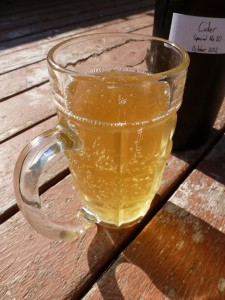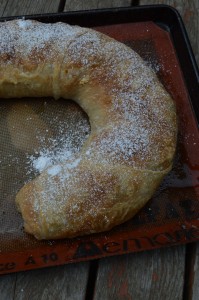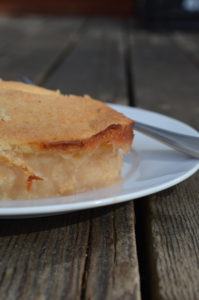Apple Johnny is a cake from eastern Canada that is baked in apple sauce. This is the third traditional cake from that region I’ve come across that is baked in a sauce or syrup. I think that’s enough to classify this as a family of cakes. I am going to call them drop cakes, because you make a batter and drop it into some manner of delicious sauce or liquid. Not a traditional term by any means but there it is.
Anyways, the most famous drop cake is pouding chômeur, which is a traditional Quebecois cake baked in maple syrup. When I mentioned this to a friend who grew up in Newfoundland and Nova Scotia, she said that they … Continue reading.
 When you have hundreds of pounds of something you start thinking deeply on how you can preserve and consume the bounty. This time of year apples are the subject of those deep thoughts. Of course cider is the supreme way to preserve and consume apples, but I’ve been experimenting with some other techniques that involve cooking and reducing the fresh apple juice.
When you have hundreds of pounds of something you start thinking deeply on how you can preserve and consume the bounty. This time of year apples are the subject of those deep thoughts. Of course cider is the supreme way to preserve and consume apples, but I’ve been experimenting with some other techniques that involve cooking and reducing the fresh apple juice.
I got the idea from the cuisine of Modena. Obviously they have an abundance of grapes, and obviously the majority of those grapes end up as wine or liquor, but they also have a few preparations made by cooking and reducing fresh grape juice. The most famous is traditional balsamic vinegar, but there is also a … Continue reading.
 On Wednesday, October 14, 2015 I’m leading a class called “Sweet & Delicious Cider Making” for Metro Continuing Education.
On Wednesday, October 14, 2015 I’m leading a class called “Sweet & Delicious Cider Making” for Metro Continuing Education.
“There are countless apple trees in Edmonton, and cider is one of the best ways to preserve and consume local apples. Learn how to make sweet and aromatic apple juice and hard cider like you’ve never tasted before. Allan will show you how to crush, press and ferment your cider using affordable homemade equipment.”
 The most common form of strudel in North America is puff pastry filled with sticky jam or compote, the final product very similar to a turnover or a chausson.
The most common form of strudel in North America is puff pastry filled with sticky jam or compote, the final product very similar to a turnover or a chausson.
The original strudel, the Viennese strudel, is a different beast entirely.
Austrian strudel is made with a simple dough consisting of flour, salt, water, and vegetable oil. High protein flour is used, and the dough is mixed extensively so that there is intensive gluten development. This allows the baker to stretch the dough until it is so thin it is almost transparent. The expression in Austrian kitchens is that the dough should be thin enough that you could hold the dough over a newspaper and read the text through the dough. … Continue reading.
 The only time you should ever peel apples is when you are going to cook them. Once cooked apple skins are hard, like photography film, if you can remember what that tastes like.
The only time you should ever peel apples is when you are going to cook them. Once cooked apple skins are hard, like photography film, if you can remember what that tastes like.
The only time I peel and cook apples is when I’m making apple pie or apple sauce, which is only a few times a year. Most of the apples that pass through our home are crushed and pressed whole to make cider. In this process the skins are broken up very fine so that they lend some body and tannin to the drink.
What I mean to say is I don’t actually peel very many apples. But when I do peel those very few apples it bothers … Continue reading.
 Some detailed notes on a North American staple.
Some detailed notes on a North American staple.
The Dough. I take for granted that you already know how to make a superlative, flaky pie dough. If you don’t, this pie dough is a good start, but you should probably add a handful of sugar to the mix.
The Filling. The first important consideration for the filling is the variety of apple to be used. High acidity and firm, crisp texture are key. Of the common commercial varieties, Granny Smith is probably the best, but there are lots of varieties growing within the Edmonton city limits that make good pie. Sweetness, of course, is also desirable, but we can balance the tartness of the apples with sugar. Look … Continue reading.
 Earlier in the month we pressed our apples into cider. The juice that ran from the press was sweet and tart, with a full, milky mouthfeel, and a subtle siltiness that I think was from the skins and seeds of the fruit. It had a cloudy, oxidated colour and was a pleasing drink in all of its many facets.
Earlier in the month we pressed our apples into cider. The juice that ran from the press was sweet and tart, with a full, milky mouthfeel, and a subtle siltiness that I think was from the skins and seeds of the fruit. It had a cloudy, oxidated colour and was a pleasing drink in all of its many facets.
Fermentation
As with grapes, there is an abundance of natural yeast living on the skins of apples, and when you crush the fruit and mix the skins with the juices, the yeast has easy access to sugar. I’m always surprised by the efficacy and consistency of this natural fermentation. Basically the cider can sit in your basement for a week, … Continue reading.
Yet ev’n this Season Pleasance blithe affords,
Now the squeez’d Press foams with our Apple Hoards.
-John Gay
To most contemporary city-folk the word “cider” implies fermented apple juice. My grandparents made the distinction between “cider” (juice pressed from apples) and “hard cider” (fermented apple juice). For now I have simply made cider, and will leave the discussion of hard cider and its variants for another post.
This week we picked about 150 lbs of apples from three different trees:
- one beautiful, well-trained tree yielding large, blushing apples, which I will be referring to as “Ron’s apples”;
- one crabapple tree with bright red, tart fruit;
- one hideous, unkempt tree in our backyard that grows small green apples. The tree
…
Continue reading.
 When rose flowers wither and fall from the plant, they leave behind a little green ball called a rose hip. In late summer those hips swell and turn red, and start to look like berries.
When rose flowers wither and fall from the plant, they leave behind a little green ball called a rose hip. In late summer those hips swell and turn red, and start to look like berries.
They are not berries, as you will discover if you open one up. Rosehips are full of seeds and what looks like white hair. If eaten raw those hairs will irritate your mouth and throat. Don’t eat those hairs raw. The fleshy part around the seeds and hair can be eaten raw. It has an interesting flavour; depending on the plant and the time of year it can taste like fresh cut grass, or a tomato, or possibly a plum.
Though rose hips can be … Continue reading.
Step One: Acquire Grouse
A friend’s father, Mr. McLarney, hunts game birds with his English pointer. I had never, not once, paused to consider the signficance of common canine descriptors like pointer, setter, and retriever, until Mr. McLarney’s hunts were explained to me. The dog walks a ways in front of him, and when it comes upon a bird it stops and “points”: it aims its snout at the prey. Mr. McLarney moves within range and readies his gun, then makes a call to the pointer. At the signal, the dog scares the bird into flight, so that Mr. McLarney can pull it from the sky with his shotgun.[1]
Mr. McLarney trained his pointer in his backyard with a … Continue reading.


 On Wednesday, October 14, 2015 I’m leading a class called “Sweet & Delicious Cider Making” for Metro Continuing Education.
On Wednesday, October 14, 2015 I’m leading a class called “Sweet & Delicious Cider Making” for Metro Continuing Education.


